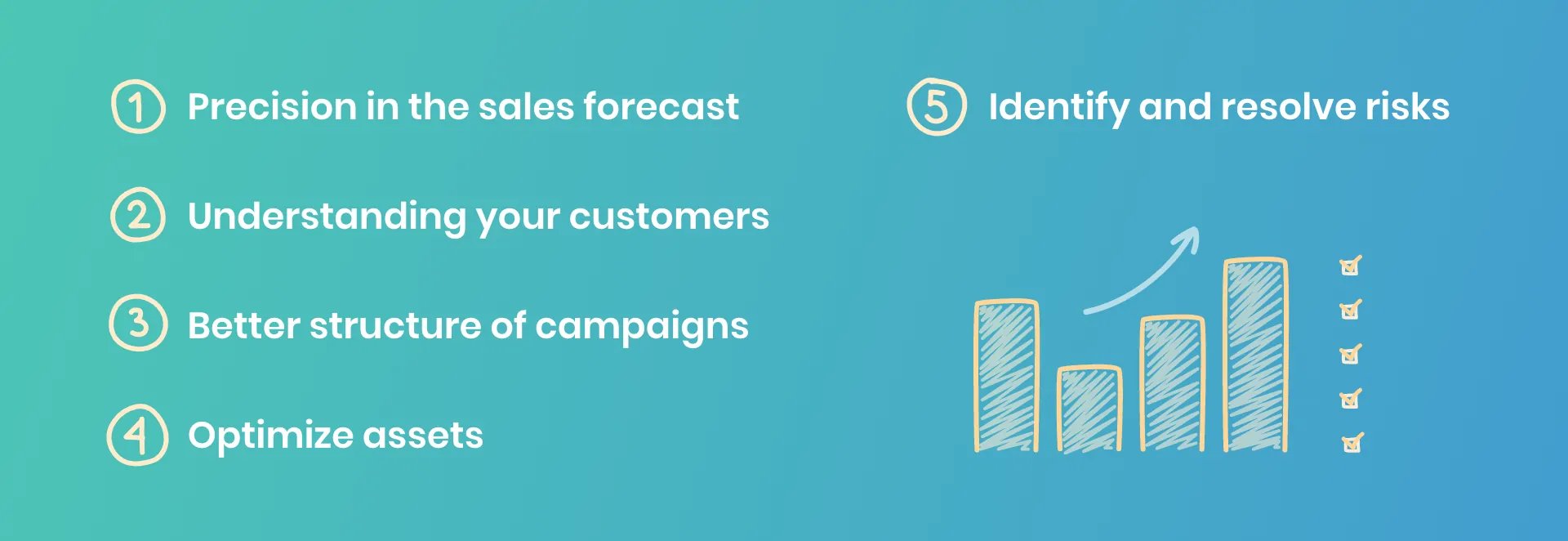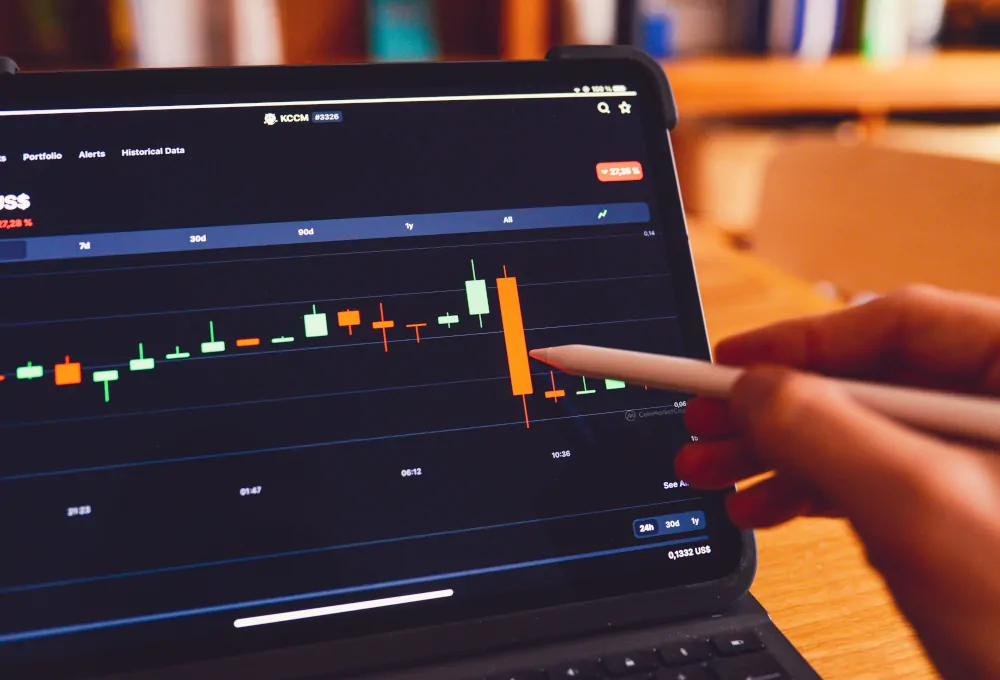To sustain a business in a cutthroat market, you must get ahead of your competition and do better in sales than your previous financial year.
Your sales forecasting needs to be as accurate as possible to achieve that feat. Without a data-driven approach, it’s likely to be unreliable. Here, predictive analysis is the way to go.
As the spotlight on sales automation and AI grows stronger, organizations worldwide are using predictive analysis to make smarter decisions. The benefits here are not limited to gauging precise sales forecasts. Predictive analytics also help in budgeting, setting manageable goals, and prospecting.
In this blog post article, we will walk you through the intricacies of predictive analysis, its benefits, and its practical application in the business.
What is predictive sales analysis?
Predictive sales analysis is the processes and software that examine the historical and current sales data sets to predict sales outcomes and enhance business performance.
The method uses statistical modeling, data mining techniques, and machine learning to find patterns in different data sets. This shows the prospective opportunities and risks.
The rise of digital marketing has made it easy for sellers to access first-party and third-party customer data. So, businesses can use predictive sales analysis for several purposes:
- Identifying quality leads
- Setting proper business goals
- Budgeting business expenses for the financial year
- Improving customer experience
- Optimizing resources in the right direction
4 ways of using predictive analysis in sales forecasting
Conducting predictive analysis does not have to be as complicated as it sounds. Here are the steps you need to follow.
1. Collect and organize past data
To generate meaningful insights, focus on collecting the right kind of data. Start with the departmental objectives or products whose sales performance you want to focus on.
In this stage, you need to measure the effectiveness of your sales training. Identify your data sources, the relevant variables, and performance metrics. Then collect sales data on your most popular products.
Gather data on your total sales and identify the peaks in your sales funnel. Determine the characteristics of your repeat customers. Make sure you organize every different data set accordingly.
Once that’s done, choose a period for collecting your data. You can opt for a weekly, monthly, quarterly, or yearly duration according to your requirements. The collection and organization of past data need to be regular.
For example, if you are struggling with customer acquisition, focus on collecting first-party and third-party data to obtain information on customer information. This way, your sales department can focus on creating a personalized customer experience.
2. Use statistical analysis to identify trends
To make effective changes in sales, your analysis process should focus on identifying trends. Trend analysis can also be used to predict your market. It will help you optimize the resources in the right direction.
Examine the historical data to identify patterns in your sales. Gauge which seasons your sales records have peaked and what periods did not work well.
Depending on your industry, sales speed up during some months and in the festive season. By looking at the numbers in historical data from previous years and months, you will determine whether the sales rate was normal in the season. You can also see if the rate peaked because of strategic changes to your sales process.
You can enhance the accuracy by ensuring a robust sales process that is flexible enough to accommodate statistical insights.
For instance, the e-commerce industry identifies trends to drive cross-selling. Amazon tracks patterns in buying habits and shows products under “Buy it with.”

3. Use predictive modeling techniques
Once you have identified the patterns and trends in your data, it’s time to introduce predictive modeling techniques in the analysis process.
Predictive modeling refers to the process an organization adopts to analyze the patterns in historical and current data to generate future predictions of sales outcomes.
This method uses machine learning and data mining and examines patterns and observes trends within specific conditions to gauge the most likely outcome. Predictive modeling enables businesses to prepare themselves to accommodate demand and drive more leads.
Some popular predictive algorithms include:
- Random forest
- Generalized linear model (GLM) for two values
- K-Means
- Gradient boosted model
- Prophet
- You only look once (YOLO)
- Convolution Neural Network (CNN)
- Auto-regressive integrated moving average (ARIMA)
- LSTM and bi-directional LSTM
- LSTM Recurrent Neural Network
Predictive modeling techniques help businesses plan the best course of action to reach the predicted goals.
For example, a restaurant needs to estimate the number of supplies to order for a specific time range. They can apply predictive modeling techniques to assess the historical data of that time range and assign factors such as nearby events and upcoming holidays to this model. The results will tell them how much to order to deliver customer needs in that period successfully. This method will work in other hospitality sectors, from ghost kitchens to tourism.
4. Use the predictions to develop a sales forecast
No amount of smart tricks will bring a positive impact if you don’t use the generated insights and make changes in your sales techniques. Once your predictive analysis process generates digital reports, it's time to share your conclusions in your next sales meeting and apply them to create a seamless sales funnel.
Don’t generate a sales forecast only to convince investors. Smart businesses use predictions to measure their progress and improve sales processes. It helps them deliver a superior customer experience and ensures they’re on the right track.
For example, Showroomprive, a French e-commerce website, uses predictive analysis to manage customer churn. They can predict customer churn with a 77% accuracy rate. Based on this prediction, they take preventative measures and increase sales.
To convert your sales forecast into actual results, gather your sales team and accounting team to conduct a monthly financial review meeting. Here you will look at your business’s finances and compare them against your predicted sales.
Benefits of predictive analysis for sales forecasting

Here are some of the benefits of using predictive analytics for sales forecasting:
1. Precision in the sales forecast
The primary reason companies should use predictive analysis is to bring accuracy to forecasting results.
A proper sales forecast considers industry trends, past sales, competitors, economic shifts, and other sources to gauge the future sales rate. Without applying technology, the process is likely to miss key metrics. Thus, manually processed insights are often prone to errors.
The application of machine learning techniques mitigates this risk. Predictive analysis accurately measures each set of data and provides actionable insights. This enables you to create SMART goals (i.e., specific, measurable, attainable, relevant, and time-bound) for your sales team.
2. Understanding your customers
Customers’ buying patterns can change anytime without any specific reason. If you don’t track their buying habits constantly, your sales rate is bound to drop.
Predictive analytics examines customer data and helps you understand your customer needs. It maps the changes in their requirements and helps you plan your sales strategy accordingly.
You understand what appeals to your target customers through data-driven actionable insights and train your sales team to deliver personalized pitches. It makes you more equipped to handle customer requests and provide them with the optimum experience.
When your sales team has enough insight to understand customers, they perform better. Sales executives will know how to keep customers happy and engaged and resolve their problems.
3. Better structure of campaigns
Running effective marketing campaigns is imperative to drive sales. Predictive analytics enables you to identify engagement, conversion rates, and campaign visibility metrics. It also helps you benchmark your performance against competitors and learn from their successes and failures. This helps you design a campaign that appeals to your target market and brings valuable leads.
4. Optimize assets
Predictive analytics offers a comprehensive view of human and non-human asset utilization. It enables you to identify bottlenecks in the business process by focusing resources on areas that need improvements. Using your assets optimally can reduce operational costs significantly and, in turn, increase profits.
For example, storage of products can become costly if inventory is not managed properly. By using predictive analytics to predict demand accurately, companies can avoid overstocking and paying for pallets they don't need. Typical pallet storage pricing is around $16/pallet/month, so having the correct amount of stock with no overages can save a lot of money.
5. Identify and resolve risks
No business is immune to risks. Changes in the economy, global conflicts, rising fuel prices, etc., can impact business results for the better or worse. Predictive analytics takes different situational and risky factors into account while generating insights. This helps you identify risks and mitigate them before it impacts your business severely. When you address problems early on, you sustain a good sales rate and remain relevant in the market.
Conclusion
While sales forecasting is not new, technology has made it much more accurate and effective. You can never fully predict the future. But having a proper predictive sales analysis process helps you make data-driven decisions.
Predictive analytics replaces the limitations of human inference and bias with objective models based on forecasting algorithms. This heightens the chances of success, driving improved sales.
It helps you understand customers' needs and nudges you to focus your resources on areas that matter the most. You set realistic goals and help your sales team achieve them through methodical and sustainable strategies.
In an era where every product has hundreds of alternatives, predictive sales analysis is your best shot at being among the frontrunners of your industry.




